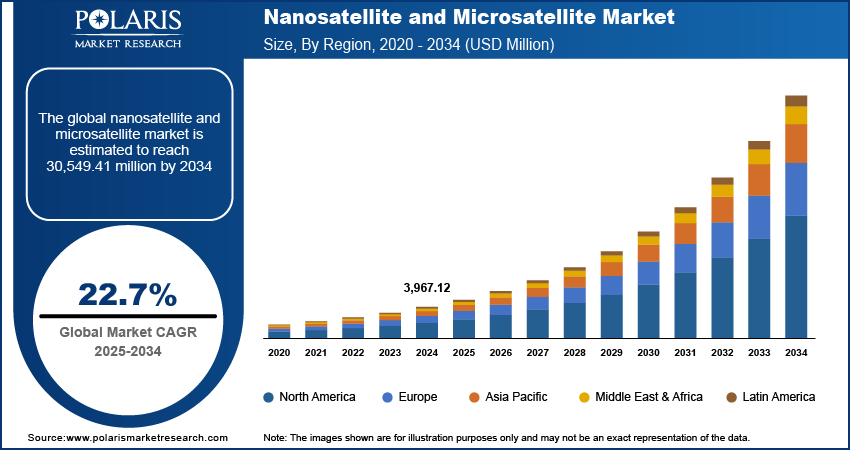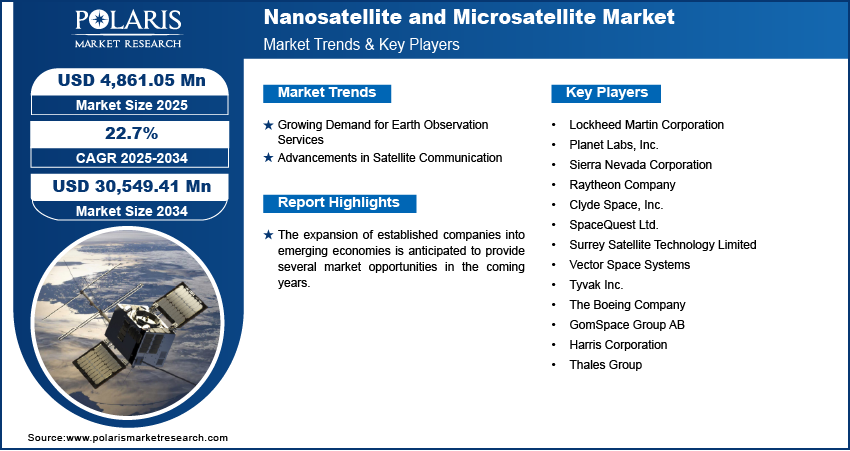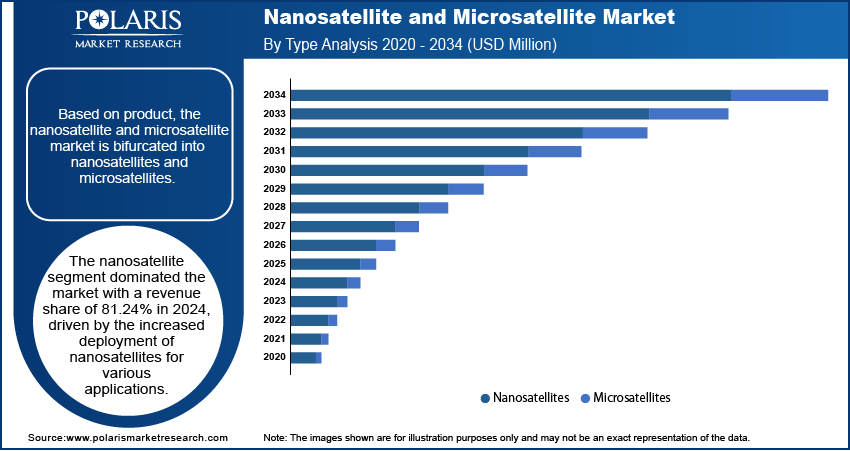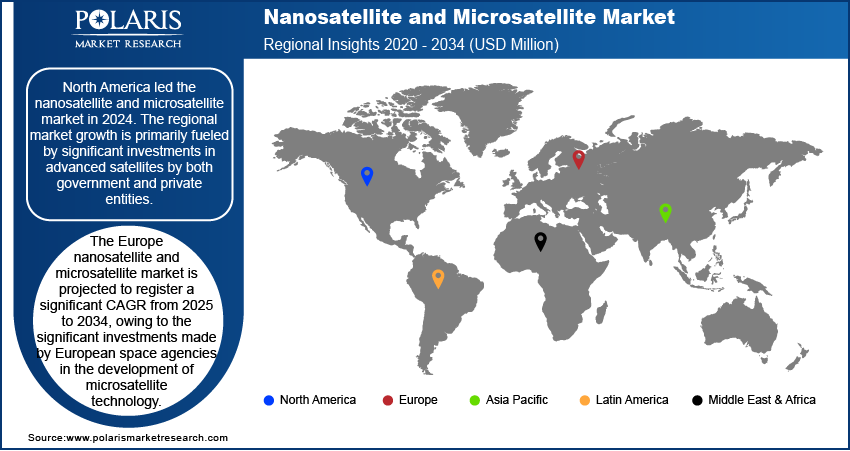
Nanosatellite and Microsatellite Market Size, Share, Trends, Industry Analysis Report: By Type (Nanosatellites and Microsatellites), Application, End Use, and Region (North America, Europe, Asia Pacific, Latin America, and Middle East & Africa) – Market Forecast, 2025–2034
- Published Date:Jan-2025
- Pages: 118
- Format: PDF
- Report ID: PM1077
- Base Year: 2024
- Historical Data: 2020-2023
Nanosatellite and Microsatellite Market Overview
The global nanosatellite and microsatellite market size was valued at USD 3,967.12 million in 2024. The market is projected to grow from USD 4,861.05 million in 2025 to USD 30,549.41 million by 2034. It is projected to exhibit a CAGR of 22.7% from 2025 to 2034.
Microsatellites are artificial satellites with a mass ranging from 10 kg to 100 kg, including the fuel mass. They are developed through the miniaturization of existing satellites, utilizing advanced technology in imaging devices, peripheral circuits, building materials, algorithms, and other components. Nanosatellites, on the other hand, are artificial satellites that weigh between 1 kg to 10 kg and typically measure around 30-by-10-by-10 centimeters. These satellites are known for their low cost, lightweight design, ease of construction and development, and high capability to perform complex computational tasks.

To Understand More About this Research: Request a Free Sample Report
The growing adoption of nanosatellites and microsatellites is driving the nanosatellite and microsatellite market growth. With companies operating large satellites looking for lighter and cost-effective platforms, there is increased demand for low-cost nanosatellites and microsatellites. The rising usage of data provided by nanosatellites and microsatellites in the commercial and civil sectors further boosts market expansion.
The rising interest of governments in nanosatellites for Earth observation and defense applications and the low cost associated with the development and operation of microsatellites are anticipated to support the nanosatellite and microsatellite market development in the coming years. The expansion of established companies into emerging economies is anticipated to provide lucrative market opportunities during the forecast period.
Nanosatellite and Microsatellite Market
Growing Demand for Earth Observation Services
Earth observation (EO) is the process of collecting information about the Earth’s surface, atmosphere, and waters. EO services gather data for a variety of purposes, including weather forecasting, climate monitoring, ecosystem accounting, and climate mitigation and adaptation. The need for high-resolution Earth imaging has increased across various sectors, as these images can be used for various applications, such as efficient management of forest, land, and water resources. Also, space-based imaging can help fulfill a country’s security, developmental, and disaster management needs. Thus, the rising demand for Earth observation is fueling the nanosatellite and microsatellite market development.
Advancements in Satellite Communication
Nanosatellites and microsatellites are playing a pivotal role in enhancing satellite communication systems. These satellites can form constellations to offer global coverage and seamless connectivity. Also, they can help bridge the digital divide and offer access to basic services in isolated regions. Also, nanosatellites and microsatellites support satellite-based connectivity for remote sensing, asset tracking, and communication. Thus, the ability of nanosatellites and microsatellites to improve satellite communication systems contributes to the nanosatellite and microsatellite market expansion.

Nanosatellite and Microsatellite Market Segment Insights
Nanosatellite and Microsatellite Market Outlook by Product Insights
The nanosatellite & microsatellite market, based on product, is bifurcated into nanosatellites and microsatellites. The nanosatellite segment dominated the market with a revenue share of 81.24% in 2024, driven by the increased deployment of nanosatellites for various applications. Nanosatellites are cost-effective and can be produced quickly as compared to their large counterparts. Also, the versatility of these satellites enables them to be used for several uses, such as scientific research, remote sensing, and data collection. These benefits of nanosatellites contribute to their high popularity and solidify their position as the leading segment in the market.
Nanosatellite and Microsatellite Market Assessment by Application Insights
The nanosatellite & microsatellite market, based on application, is segmented into Earth observation, communication, technology demonstration, biological experimentation, scientific research & academic training, and others. The scientific research & academic training segment is anticipated to register a significant CAGR from 2025 to 2034. The segment’s growth is largely fueled by the growing utilization of nanosatellites and microsatellites in academic and research institutions. These satellites allow researchers and scientists to carry out experiments in space and collect information on greenhouse emissions with lower costs and high efficiency. In addition, the rapid development cycles of these satellites enable quicker advancements of research missions, supporting ongoing research studies in various fields.

Nanosatellite and Microsatellite Market Regional Analysis
By region, the market report offers nanosatellite and microsatellite market insights into North America, Europe, Asia Pacific, Latin America, and the Middle East & Africa. North America led the market with a revenue share of 46.12% in 2024. The regional market growth is primarily fueled by significant investments in advanced satellites by both government and private entities. Also, the presence of several market participants leading the development of innovative satellite solutions contributes to the market development in the region.
The Europe nanosatellite and microsatellite market is projected to register a significant CAGR of 23.8% from 2025 to 2034. Space agencies in Europe are making significant investments in the development of microsatellite technology for Earth observation and scientific missions. Further, market participants and European academic institutions are focusing on creating innovative solutions for microsatellites and investigating novel applications in areas such as environmental monitoring and maritime surveillance, thereby propelling market growth in the region.

Nanosatellite and Microsatellite Market – Key Players and Competitive Insights
The market for nanosatellites and microsatellites has the presence of both established players and new entrants. The leading market players focus on offering advanced products to improve their offerings. Also, they are undertaking various strategic initiatives such as collaborations, mergers and acquisitions, and partnerships to increase their market share. To expand and survive in a more competitive and rising market environment, market participants must offer innovative solutions.
Manufacturing locally is one of the key business strategies used by manufacturers to benefit clients and increase the market sector. In recent years, the market has witnessed several technological and innovation breakthroughs. The nanosatellite and microsatellite market research report offers a market assessment of all the leading market players, including Lockheed Martin Corporation; Planet Labs, Inc.; Sierra Nevada Corporation; Raytheon Company; Clyde Space, Inc.; SpaceQuest Ltd.; Surrey Satellite Technology Limited; Vector Space Systems; Tyvak Inc.; The Boeing Company; GomSpace Group AB; Harris Corporation; and Thales Group.
List of Key Players in Nanosatellite and Microsatellite Market
- Lockheed Martin Corporation
- Planet Labs, Inc.
- Sierra Nevada Corporation
- Raytheon Company
- Clyde Space, Inc.
- SpaceQuest Ltd.
- Surrey Satellite Technology Limited
- Vector Space Systems
- Tyvak Inc.
- The Boeing Company
- GomSpace Group AB
- Harris Corporation
- Thales Group
Nanosatellite and Microsatellite Industry Developments
November 2024: Surrey Satellite Technology Limited announced the signing of a contract with the UK Ministry of Defense for supplying an Earth observation satellite. The company stated that the satellite, named Juno, is expected to launch in 2027 and capture daytime images of the Earth’s surface to provide critical data for military operations.
August 2024: Sierra Nevada Corporation (SNC) announced significant advances to its Vindlér commercial radio frequency (RF) technology through a partnership with Muon Space. According to SNC, the new partnership will focus on the development and delivery of three additional satellites to SNC’s constellation.
Nanosatellite and Microsatellite Market Segmentation
By Type Outlook
- Nanosatellites
- Microsatellites
By Application Outlook
- Earth Observation
- Communication
- Technology Demonstration
- Biological Experimentation
- Scientific Research & Academic Training
- Others
By End Use Outlook
- Defense
- Civil and Construction
- Government
- Energy
- Commercial
- Others
By Regional Outlook
- North America
- US
- Canada
- Europe
- Germany
- France
- UK
- Italy
- Spain
- Netherlands
- Russia
- Rest of Europe
- Asia Pacific
- China
- Japan
- India
- Malaysia
- South Korea
- Indonesia
- Australia
- Rest of Asia Pacific
- Middle East & Africa
- Saudi Arabia
- UAE
- Israel
- South Africa
- Rest of Middle East & Africa
- Latin America
- Mexico
- Brazil
- Argentina
- Rest of Latin America
Nanosatellite and Microsatellite Market Report Scope
|
Report Attributes |
Details |
|
Market Size Value in 2024 |
USD 3,967.12 million |
|
Market Size Value in 2025 |
USD 4,861.05 million |
|
Revenue Forecast by 2034 |
USD 30,549.41 million |
|
CAGR |
22.7% from 2025 to 2034 |
|
Base Year |
2024 |
|
Historical Data |
2020–2023 |
|
Forecast Period |
2025–2034 |
|
Quantitative Units |
Revenue in USD million and CAGR from 2025 to 2034 |
|
Report Coverage |
Revenue Forecast, Market Competitive Landscape, Growth Factors, and Trends |
|
Segments Covered |
|
|
Regional Scope |
|
|
Competitive Landscape |
|
|
Report Format |
|
|
Customization |
Report customization as per your requirements with respect to countries, regions, and segmentation. |
FAQ's
The market was valued at USD 3,967.12 million in 2024 and is projected to grow to USD 30,549.41 million by 2034.
The market is projected to register a CAGR of 22.7% from 2025 to 2034.
North America accounted for the largest region-wise market size in 2024.
Lockheed Martin Corporation; Planet Labs, Inc.; Sierra Nevada Corporation; Raytheon Company; Clyde Space, Inc.; SpaceQuest Ltd.; Surrey Satellite Technology Limited; Vector Space Systems; Tyvak Inc.; The Boeing Company; GomSpace Group AB; Harris Corporation; and Thales Group are a few of the key players in the market.
The nanosatellite segment accounted for a larger market share in 2024.
The scientific research & academic training segment is anticipated to witness a significant CAGR during the forecast period.
